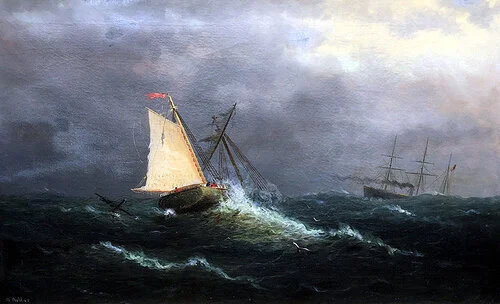Wesley Webber
(1841 - 1914)
Landscape and marine painter Wesley Webber was born in Gardiner, Maine and died in Wollaston, Massachusetts in November 1914. He lived in Boston from 1870 to 1890 and in New York City from 1892 and was self-taught. He is considered one of the finer landscape painters who painted from life in the Conway area of New Hampshire and along the New England coast and he is reminiscent of the Hudson River School in style and manner.
Webber served in the Civil War (Company B of the Sixteenth Maine Volunteer Infantry Regiment) and was present at General Lee's surrender at Appomattox. His original sketches made at the surrender, along with his finished illustrations of the Civil War were shown at the Boston Art Club and brought Webber considerable fame, recognition and fortune. Many of his Civil War scenes were published as wood engravings in Harper's Weekly and as a lithograph published by J.H. Bufford of Boston. He was discharged from Civil War service in Augusta, Maine, June 15, 1865 and he opened a studio in Gardiner, where he became a carriage painter. Thereafter, Webber earned a fine reputation as a marine and landscape painter, but at the end of his life (ca. 1900-1914) he became an alcoholic and his style weakened along with his reputation.
Every summer he went to Conway, New Hampshire to paint the hillside, where painters John J. Enneking, Frank Shapleigh and others joined him to paint. He also painted in Manchester-by-the-Sea, in Nova Scotia and in Canada. Two of his most famous paintings are "Kennebec River", "Maine Boat Shop and Unidentified Vessels Ice-bound at Gloucester" (both at the Peabody Museum, Salem, MA). He is also represented in the permanent collections of the Boston Athenaeum; New York Public Library; the Brooklyn Museum; Portland Museum of Art (Maine) and elsewhere. Following his death, his family sold the contents of his studio at the Boston auction house of C.F. Libbie and Company.
